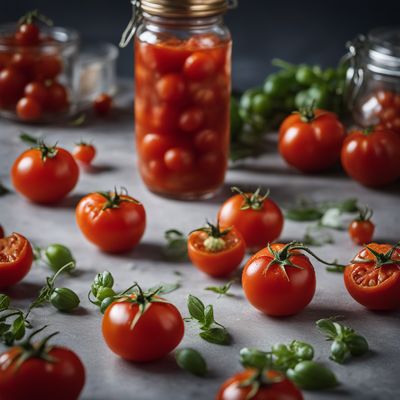
Ingredient
Sun-dried tomatoes
"The Intense Essence of the Sun: Unveiling the World of Sun-dried Tomatoes"
Sun-dried tomatoes are ripe tomatoes that have been dehydrated to remove most of their moisture content. This process intensifies their natural flavors, resulting in a rich, sweet, and slightly tangy taste. The texture of sun-dried tomatoes is chewy and leathery, providing a delightful contrast to other ingredients in a dish. They have a deep red color and are often preserved in oil to maintain their moisture and enhance their flavor.
Origins and history
Sun-dried tomatoes have a long history dating back to ancient civilizations such as the Aztecs and Incas, who used the sun-drying technique to preserve their harvest. The practice of sun-drying tomatoes originated in the Mediterranean region, particularly in Italy, where the warm climate and abundant sunshine provided the perfect conditions for drying tomatoes. Over time, sun-dried tomatoes gained popularity worldwide and became a staple in Mediterranean cuisine.
Nutritional information
Sun-dried tomatoes are a good source of vitamins A and C, as well as dietary fiber. They also contain lycopene, a powerful antioxidant known for its potential health benefits. In a 1-ounce (28g) serving, sun-dried tomatoes provide approximately 100 calories.
How to select
When selecting sun-dried tomatoes, look for plump and slightly soft ones that are not overly dry or brittle. Avoid those with mold or an off-putting odor. Opt for sun-dried tomatoes that are packed in oil, as they tend to be more flavorful and moist.
Storage recommendations
To maintain the freshness and quality of sun-dried tomatoes, store them in an airtight container in a cool, dark place. If they are packed in oil, ensure they are fully submerged to prevent spoilage. Properly stored, sun-dried tomatoes can last for several months.
How to produce
To produce sun-dried tomatoes at home, start by slicing ripe tomatoes into thin, even slices. Arrange them on a baking sheet and sprinkle with salt. Place the baking sheet in direct sunlight or use a food dehydrator to dry the tomatoes slowly until they become leathery and dry. Store them in an airtight container, submerged in olive oil for added moisture and flavor.
Preparation tips
Sun-dried tomatoes can be used in various ways. They can be rehydrated by soaking them in warm water or oil before use, or added directly to dishes for an intense burst of flavor. They are excellent in pasta sauces, salads, sandwiches, and as a topping for pizzas. To enhance their flavor, lightly toast them in a dry pan before incorporating them into your recipes.
Substitutions
If sun-dried tomatoes are not available, you can substitute them with rehydrated dried tomatoes or roasted red peppers for a similar flavor profile and texture.
Culinary uses
Sun-dried tomatoes are widely used in Mediterranean cuisine, adding depth and complexity to dishes. They are commonly used in pasta sauces, bruschetta, salads, and antipasti platters. They can also be blended into pesto or incorporated into bread dough for a flavorful twist.
Availability
Sun-dried tomatoes are commonly available in Mediterranean countries such as Italy, Greece, and Turkey. They are also cultivated and produced in other regions with suitable climates, including California in the United States.
More ingredients from this category
Recipes using Sun-dried tomatoes » Browse all

Babor - Curaçao Style Spiced Meatballs
Savory Delights: Curaçaoan Spiced Meatballs with a North African Twist

Cincinnati Chili with a Twist
Spiced Delight: A Unique Twist on Cincinnati Chili

Cucciole with Tomato and Basil Sauce
Savory Delight: Cucciole in a Burst of Tomato and Basil

Zuppa alla Ueca with a Twist
Savory Italian Vegetable Soup with a Burst of Flavor

Ciriola with Tomato and Basil Sauce
Savory Delight: Ciriola Pasta with Fresh Tomato and Basil Sauce

Italian Lentil Stew
Hearty Lentil Delight: A Taste of Italy

Ceredigion-inspired Faux Sugo
Hearty Welsh Tomato Stew

East Asian Style Spicy Beef Stew
Fiery Beef Delight: East Asian Style Spicy Beef Stew

Milanesa Napolitana with a South Sudanese Twist
Savory Breaded Chicken with Tomato Sauce and Cheese, South Sudanese Style

Bavarian Cabbage Stew
Bavarian Comfort: Hearty Cabbage Stew with a Bavarian Twist

Egyptian-style Potée Lorraine
Savory Egyptian Stew: A Fusion of French and Egyptian Flavors

Muisca Spicy Stew
Andean Fire: A Spicy Journey through Muisca Cuisine
